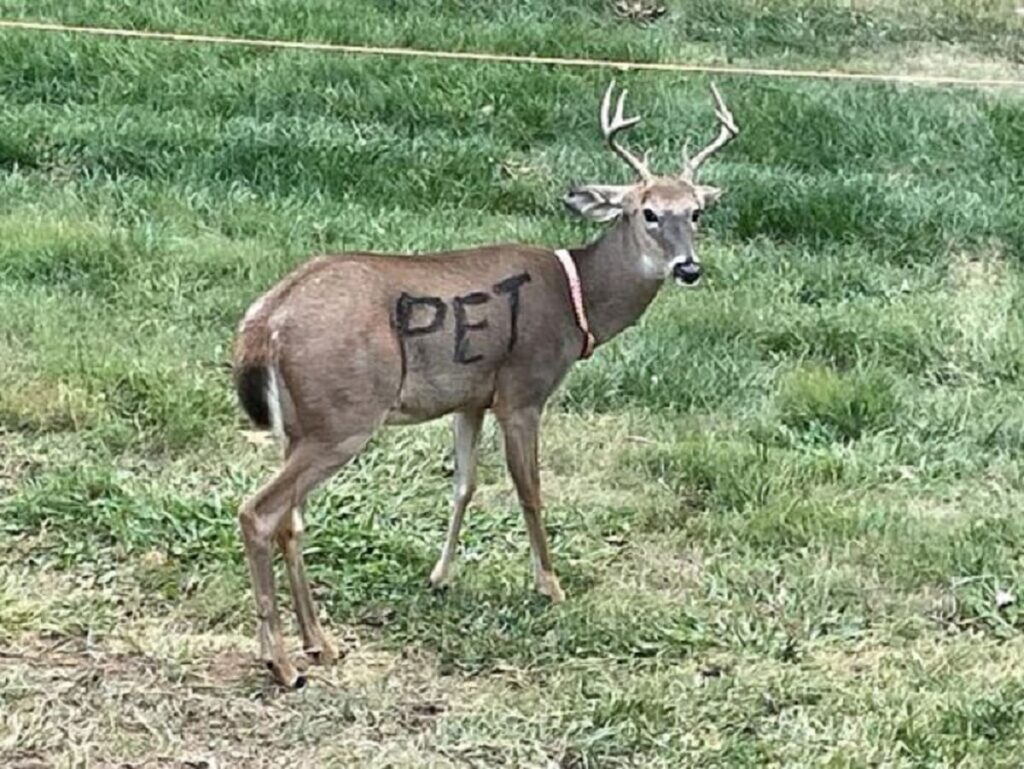In a bizarre encounter that sounds more like the plot of a whimsical novel than real life, a property owner in rural Missouri stumbled upon something truly unexpected. While walking across his land, he spotted a deer wandering nearby—wearing a bright, colorful collar. But what made this sight even more surreal was the word “pet” painted on the animal’s side, adding a strange touch to the already unusual scenario.
The Mysterious Sighting
This unusual event took place in late September, in Jefferson County, Missouri. The property owner’s curiosity quickly turned to concern when he saw the deer with its odd adornments. The sighting, while puzzling, prompted local authorities to investigate. According to a report by People magazine, the Jefferson County Sheriff’s Office dispatched a team to the scene. However, by the time they arrived, the deer had mysteriously disappeared.
Missouri Department of Conservation (MDC) officials speculated that someone might have tried to domesticate the animal, possibly attempting to keep it as a pet—a theory supported by the presence of the collar. This type of collar, usually associated with domesticated animals, is rarely seen on wild creatures like deer.
Concern for the Deer’s Well-Being
As the story unfolded, local officials and wildlife experts expressed growing concerns for the health and safety of the deer. Scott Corley, a wildlife protection officer, voiced his worries to the press, emphasizing the need for intervention to ensure the animal’s well-being. The MDC has been monitoring the situation closely, though the deer’s whereabouts remain unknown.
The incident has raised important questions about the treatment of wild animals, particularly in terms of how they interact with human-made environments. Many believe that the collar and the word “pet” on the deer’s side were signs of someone’s attempt to domesticate it, but this presents serious risks to the animal’s health and safety.

Wildlife Is Not for Domestic Life
This peculiar encounter also brought to light the dangers of trying to treat wild animals as pets. The Missouri Department of Conservation issued a strong reminder about the importance of respecting the natural order of wildlife. “Wild animals, especially deer, should not be treated as pets,” the department stressed. In fact, handling or even getting too close to wild animals can be dangerous, not only for people but for the animals themselves.
One of the main concerns, as explained by the MDC, is the possibility of Chronic Wasting Disease (CWD). This fatal and incurable disease affects the nervous system of cervids, including deer, elk, and moose. It can spread easily between animals, and the presence of human interaction only increases the risk. For this reason, officials are urging the public to avoid contact with wild animals, as it can lead to the spread of dangerous diseases.
The Importance of Protecting Wild Habitats
In addition to concerns about the disease, the Jefferson County Sheriff’s Office took to social media to remind people that wild animals belong in their natural habitats. “Wild animals should not be treated as pets, particularly deer, which should not be removed from their natural environment,” they posted on Facebook. This sentiment was echoed by Corley, who warned that the deer’s behavior could become unpredictable, especially during the mating season. Wild deer can be more aggressive during this time, and the added stress of domestication could lead to even more dangerous behavior.
Efforts are now underway to safely capture the deer, remove the collar, and release it back into the wild where it belongs. This strange event serves as a powerful reminder of the delicate balance between humans and wildlife, highlighting the importance of respecting animals’ natural behaviors and environments.
As we witness more and more stories like this, it’s a good time to reflect on how we interact with the animals around us. While the sight of a deer with a collar may seem harmless, it’s a reminder that wild animals thrive best when they are allowed to live freely and naturally in their habitats.






